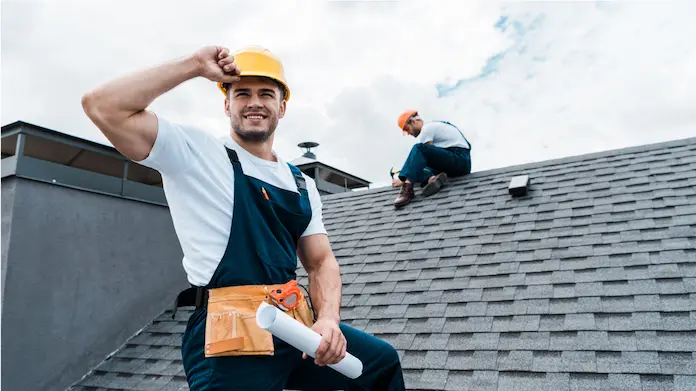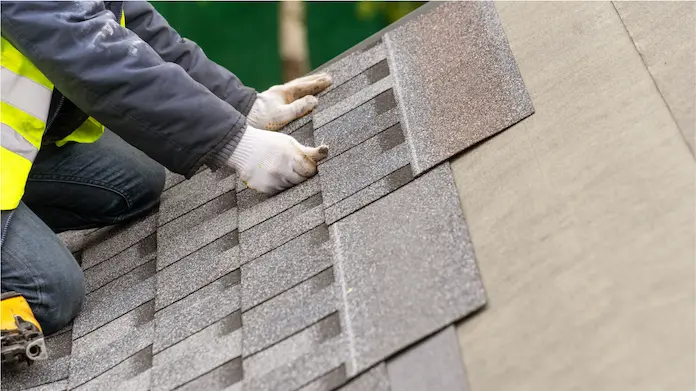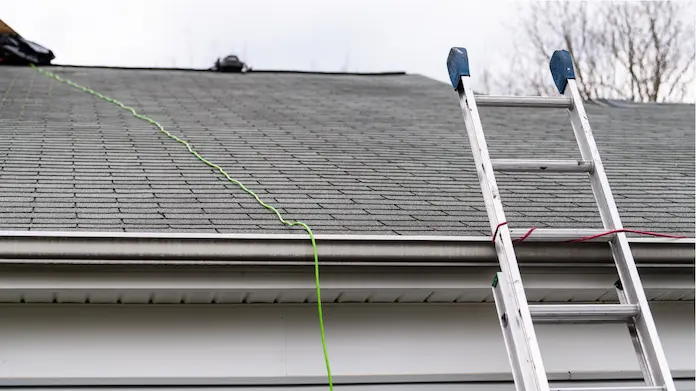How Much Does it Cost to Repair a Roof?
Key Points
- Roof repair costs can vary between $150 and $8,000, but most homeowners typically spend about $1,150.
- The final cost depends on factors such as the type of repair, location, roof type and size, roof pitch, and roofing material.
- Signs that a roof needs repairing include missing shingles, leaks, sagging, mold growth, or visible damage like cracks and curling.
Average Roof Repair Cost
Knowing the average roof repair cost can help you budget better and steer clear of unexpected expenses. Here’s a detailed overview of what to expect when fixing your roof.
Type of Repair
Minor Repairs
Minor repairs, such as fixing small leaks or replacing a few shingles, tend to be more affordable, typically ranging from $150 to $1,500. These repairs are often quick and can be completed within a few hours.
Here are some of the examples of minor roof repairs:
Moderate Repairs
Moderate repairs are more complex than minor fixes, as they tackle issues that impact the roof's performance. These repairs typically cost between $1,001 and $2,000 due to the added time and effort involved.
Some examples of moderate roof repairs include:
Major Repairs
Major repairs typically range from $1,500 to $8,000 and are much more complex than minor fixes. They often involve substantial labor and materials, which can significantly increase the overall cost.
Here are some of the examples of major roof repairs:
Replacement
Roof replacement involves removing all existing roofing materials down to the decking and installing a new roof. It's necessary for extensive damage or when the roof's lifespan ends.
Roof replacements can cost anywhere from $6,700 to $80,000, depending on the size, complexity, and materials. However, most homeowners typically spend around $11,500 for a full replacement.
Roof Material
The type of roofing material greatly impacts the repair cost, as prices, installation difficulty, and durability vary for each material.
- Roof Material Type Average Repair Cost
- Asphalt Shingles $875
- Metal Roof $1,580
- Composite Shingle Roof $900
- Tar and Gravel Roof $300 - $1,000
- Rubber or PVC Roof $400 - $1,200
- Slate Roof $1,625
- Wood Shakes $750
- Tile Roof $1,350
Asphalt Shingles
Asphalt shingles are the most common and affordable roofing material, known for their versatility and ease of installation. They are relatively simple to repair since individual shingles can be replaced without much hassle.
The cost of repairing asphalt shingles is typically around $875, making them a budget-friendly option.
Metal Roof
Metal roofs are known for their durability and weather resistance and come in many styles.
While they have a long lifespan, repairs can be challenging and often need specialized labor, especially for dents, leaks, or rust. On average, metal roof repairs cost about $1,580, depending on the damage.
Composite Shingle Roof
Composite shingles are a durable, lightweight roofing option and an attractive alternative to asphalt shingles. Repairing them usually involves matching the existing material, with costs typically averaging around $900.
Tar and Gravel Roof
These roofs are made of tar paper and hot tar layers, topped with gravel. Repairs may involve resealing or patching the surface, with costs typically ranging from $300 to $1,000, depending on the severity of the problem.
Rubber or PVC Roof
Commonly used for flat roofs, rubber (EPDM) and PVC materials are durable and flexible. While they are relatively easy to patch, more extensive repairs might require replacing sections of the roofing material.
Repair costs for rubber or PVC roofs usually range from $400 to $1,200, depending on the extent of the damage and the material used.
Slate Roof
Because of its weight and fragility, repairing a slate roof requires skilled labor to prevent additional damage. Repair costs can be quite high, averaging up to $1,625.
Wood Shakes
Wood shakes are prone to rot and weather damage, with repairs requiring careful wood matching and addressing potential issues like mold.
The cost to repair wooden shakes or shingles typically averages around $750, depending on the wood type and damage extent.
Tile Roof
Tile roofs, whether clay or concrete, are known for their durability and fire resistance. While they can last for decades, individual tiles are susceptible to cracking.
Repairs can be tricky and require careful tile handling. The cost usually averages around $1,350, depending on the complexity and type of tile.
Roof Size
Roof size significantly affects repair costs since larger roofs need more materials (shingles, underlayment) and labor. Bigger roofs take longer to fix, which increases labor expenses.
In short, the larger the roof, the more materials, labor, and effort required, driving up the overall repair costs.
Pitch/Design
Labor
Labor costs for roof repairs depend on the material, roof complexity, and extent of the damage. Features like complex designs, steep slopes, and skylights can drive up these costs.
Basically, the longer the repair takes, the higher the labor charges. Roofers typically charge between $35 and $90 per hour for their repair services.
Other Potential Cost Factors of Roof Repair

In addition to the most common ones above, let’s explore other cost factors that could impact your roof fixing price.
Time of Year
During peak roofing season in spring and summer, costs are higher due to increased demand. In the off-season, like fall or mild winters, you can get a 10-15% discount. Winter repairs are generally more expensive because snow and ice make the work riskier, potentially increasing costs by up to 100%.
Warranties
Location
Location plays a major role in roof repair costs because of factors like climate, local labor rates, material availability, and regional regulations.
In areas with extreme weather (such as heavy snow, storms, or intense heat), more durable materials and specialized labor may be needed, driving up costs.
Urban areas often have higher labor rates and permit fees than rural locations. Additionally, material costs can vary based on how close you are to suppliers or distribution centers.
Permits
Permits can greatly affect roof repair costs, as many regions require them to ensure the work meets local building codes and safety standards. Fees typically range from $100 to $500, depending on your location and the scope of the repairs.
Skipping permits can lead to fines, delays, or even a shutdown of the project, so it’s always best to check with your local authorities first.
Roof Features
Roof features like chimneys, skylights, dormers, valleys, and vents can significantly increase repair costs. These elements add complexity, requiring extra labor and materials to work around or integrate into the repairs.
Simply put, the more features a roof has, the more time, effort, and materials will be needed, which will increase the overall cost.
Roof Replacement vs. Repair

When deciding between roof replacement and repair, you should consider these points:
When to Repair
- Age & Damage: Ideal for newer roofs (less than 10-15 years old) with minor issues, such as small leaks or a few missing shingles.
- Cost: Repairs are generally cheaper, averaging around $1,150, but the cumulative cost of frequent repairs might justify replacement.
- Pros: Extends the life of your roof and is quicker to complete.
- Cons: Repairs can be temporary and may not match the rest of the roof, and they don't come with a warranty.
When to Replace
- Extensive Damage: For large areas of damage, especially if it affects the roof deck, replacement is more cost-effective.
- Old Roof: If the roof is nearing the end of its lifespan (around 25 years), replacement is often the better investment.
- Pros: A new roof lasts longer, comes with a warranty, and can enhance curb appeal.
- Cons: Higher upfront cost (around $11,500) and requires more time to complete.
How to Reduce Roof Repair Costs?
- Regular Maintenance: Routine inspections and cleaning can help identify minor issues before they escalate into costly repairs.
- Timely Repairs: Address any damage, such as leaks or missing shingles, immediately to prevent further deterioration.
- Choose Quality Materials: Investing in durable materials like impact-resistant shingles or metal roofing can reduce long-term costs.
- Insurance and Warranties: Utilize your homeowner’s insurance and any roofing warranties.
- Schedule Off-Season Repairs: Roofing companies may offer discounts during their off-peak seasons.
- Check for Local Grants or Rebates: Some areas provide incentives for energy-efficient roofing or storm damage repairs.
- DIY Minor Repairs: Handle simple tasks like cleaning gutters, replacing a few shingles, or fixing small leaks yourself if you have the skills.
- Get Multiple Quotes: Compare contractors for the best value.
Should You Repair Your Roof Yourself or Hire a Professional?

DIY repairs can help you save money and offer flexibility, but come with risks like safety hazards, lack of expertise, and the potential to void warranties. Mistakes can lead to further damage and increased costs.
Professionals bring experience, safety equipment, and quality workmanship, ensuring repairs meet industry standards. While hiring a professional is more expensive, it often provides peace of mind and long-lasting results.
DIY is fine for minor issues if you have experience, while complex repairs should be left to professionals.
How to Hire a Professional?
To hire a professional roofer, start by getting referrals from friends or family. Look into each contractor to confirm they are licensed, insured, and have good online reviews.
You can also set up meetings with potential roofers to go over the project, ask questions, and get references.
Make sure to get several quotes, but don’t choose solely based on price – prioritize quality and trust. Your contract must outline all details, like materials, payment, and warranties.
Furthermore, you can use a tool like HomeBuddy to quickly find a professional local roofer who can answer your project-related questions and even offer a free quote.
Conclusion
The average roof repair estimate ranges from $150 to $8,000, depending on factors like the type of repair, roofing material, roof size, design, and labor.
While you can save money by DIYing, it’s best to hire a professional for the job to ensure it’s done safely and correctly, avoiding future costly repairs. You can always use a tool like HomeBuddy to find a local roofing contractor and even get a free estimate.
Frequently Asked Questions
- How do I know if my roof needs replacing?
Signs your roof needs replacing include missing, curled, or cracked shingles, leaks or water damage inside, sagging roofline, moss or mold growth, granules in gutters, and a roof age of 20+ years. A professional inspection can confirm the roof’s condition.
- What are signs you need a roof repair?
- Signs you need a roof repair include missing or damaged shingles, water stains on ceilings or walls, leaks, sagging roof areas, increased energy bills, mold or moss growth, and granules in gutters. Prompt repair can prevent more extensive damage.
- How long does a roof last?
- A roof’s lifespan varies by material – asphalt shingles last 15-30 years, wood shingles 20-40 years, metal roofs 40-70 years, and clay or slate tiles can exceed 50 years. Regular maintenance and weather conditions also impact longevity.
- Does homeowners insurance cover roof repairs?
- Homeowners insurance typically covers roof repairs if the damage is due to sudden, accidental events like storms, fire, or vandalism. It usually doesn’t cover damage from general wear and tear, neglect, or poor maintenance. Be sure to review your policy for detailed coverage information.
- What are the benefits of repairing a roof?
- Repairing your roof offers several benefits, such as extending its lifespan, improving energy efficiency, enhancing your home’s curb appeal, preventing further property damage, and saving on future costly repairs. Timely repairs can also keep you and your family safe from hazards like mold growth and leaks.
